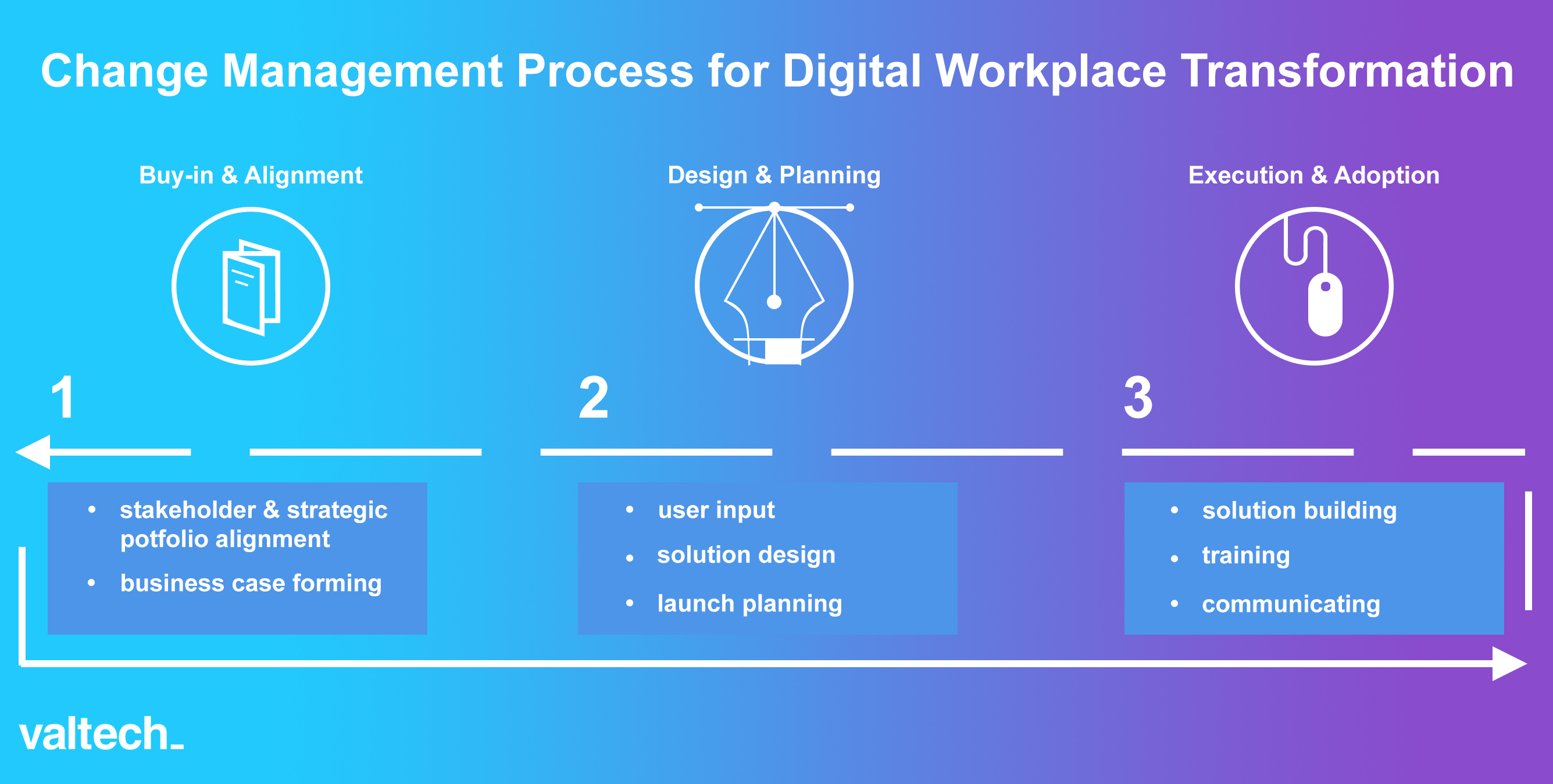Frequent digital transformations are the result of increased business demands stemming from evolving technology and the requirements of constantly improving productivity – this causes firms to implement new systems that require fast adoption by its employee base.
Because this shift and the resulting need for change management are now very prevalent across sectors and disciplines, the ability to drive these projects is becoming an important competency for most management roles in modern organizations.
As with many large transformation projects, digital workplace initiatives can often meet with friction before, during, and after they’re run. Some of the most common reasons are the following:
- Cultural: slow organizational adoption readiness – “Laggard “culture or one not aligned with the new technology’s use (Ex.- data usage maturity, internal social networking, etc.)
- Financial & Political: Misalignment of IT software and infrastructure investments – Competing platforms with integration issues, legacy systems, or exaggerated security concerns.
- Technological: new technology usability – either it’s too new to be considered seriously, or it’s not understood by users and uncomfortable to administrators.
Addressing these issues involves really getting at the core business use case for the investment, to justify the time and costs for the new digital workplace technology and its practices into action. Further, once selected – aligning the new technology with internal stakeholders across the firm is vital. While typical change processes can be thought of in a linear, project-based fashion, the evolving global marketplace is causing firms to be adaptive and embrace more agile development models. So the typical implementation and change management processes must be adapted and applied in a more reflexive, continuous fashion to be effective.
Adoption and buy-in in digital workplace transformations can work in the following manner, with most efforts in part 2 and 3 of the design and launch phases, but can be conducted in various ways. Iterations can assist in more flexible and agile development:

This process can be simplified into two major core areas: gaining buy-in, and adoption and user engagement.
Gaining buy-in
There are multitudes of books on management and change in organizations, and for the most part these involve tackling initiatives in ways to make sure senior leaders understand or are sufficiently involved, and gaining involvement from people in different units and levels. This also involves ensuring that strategies are connected to reality on the ground with competing investments, interests and projects. Leading industry expertise suggests the keys to managing difficulties are:
- Identifying and working with the right stakeholders: Working with decision-makers across the organization in key positions and ongoing development of a governance and relationship structure.
- Formulating a relatable vision: that compels others to take interest and concern.
- Discovery and consultation: across organization, particularly front line users, to gain input. This can also involve doing a diagnosis and analysis of the organization, its policies, procedures and culture through the use of collecting organizational artifacts and workflows to understand the ability of those affected by the transformation to adapt within the constraints of the firm. It helps to look intensely at the organization’s overall culture of trust, it’s flexibility and general level of autonomy that it inlays in employees’ roles.
This leads to taking account of the end user needs, and how to get them up to speed with the best practices for using digital workplace tools to deliver value on the initial business case.
Adoption and engagement
To start getting your solution right, you need to start by gaining requirements and trust from first line users and managers. The information people provide is the insight you need to create in-depth persona profiles and begin to prioritize the functionality and design for the end-product or solution.
- Creating user personas and stories: User personas help you design an effective product solution that has the best functionality and features that users need and want. Participatory design ensures that buy-in is gained throughout the design process. By including user stories and personas, into the design process, you’ll be able to understand people’s willingness to experiment, learn, and change – the underlying culture and behaviours that should be addressed. A firm may already have such personas or be developing them– so it’s good to include this. Collecting actual attitudes towards the change can be difficult as simple surveys/interviews may not be 100% reliable. It helps to look at what a certain group of employees may risk losing – control, recognition, expertise, etc. These factors, (as well as organizational culture) directly impact how employees will really be able to change and adapt, and give better understanding to their responses.
Once you have the information about your users, skills, and attitude, you need to analyze what the new system will mean to your audience and how it will affect their working day. This vital information feeds both into product design and to the training and communication actions. - Workshops, training and advocacy: Users across any organization will have different knowledge levels and approaches to technology. Though potentially frustrating –there are several ways to address this. Luckily, this type of literacy can be easily taught with targeted innovative training. A recent trend is to create advocate networks in large organizations, to both help gather input but also act as change agents that are trained as super users to help other quickly onboard to any new digital process.
- Monitoring and corrective actions: It’s also useful to back up the progress of your initiative with evidence of its success by creating KPIs to measure the outcomes. This should be adapted to the platform and created with stakeholders throughout the implementation.
While this sounds fairly easy, it can be a challenge to align the goals of the project and adapt to changing needs, while delivering the initial and expected innovative value when faced with unknowns. Gartner has outlined an 8 building blocks model that highlights the core areas that need to be addressed in digital workplace transformations. This model can help focus such efforts if and when difficulties arise.
Real-world change management applied to successful digital workplace innovations
To get a better picture of how digital workplaces solutions are realized, look to the following examples of Valtech's clients in the Manufacturing and Telecommunications sectors. Contact Valtech for more details about digital workplace innovation cases and examples.
Manufacturing/Plastic
A global manufacturing company used rapid prototyping and user persona design to develop a client portal with advanced functionality and monitoring to assist them in the management of clients. The portal also assisted client customers better interact with their firm, thus creating a better client experience and account management process, with clearer transparency and improved service levels.
Telecommunications
One of Canada’s largest telecommunications companies redesigned their intranet using a multi-step agile approach. This began with a rapid prototyping process to develop a custom solution featuring custom branding; KPI dashboards; full search capabilities; application mash-ups, and personalized features. This was used as the springboard for a full intranet redesign that involved focus groups and iterative UX design. Governance and content strategy that aligned to the corporate objectives and departmental needs helped ensure adoption and successful performance of the overall solution.





